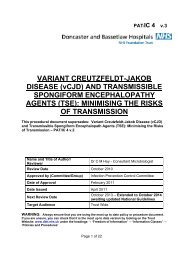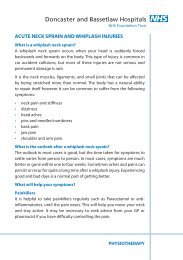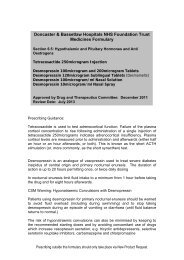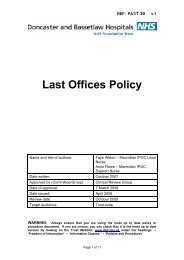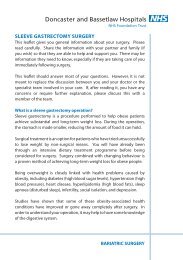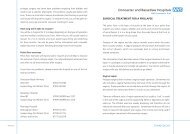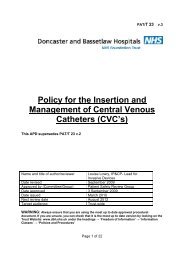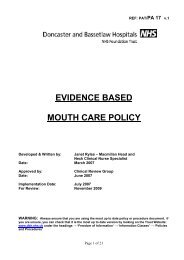bassetlaw hospital bed management policy - Doncaster and ...
bassetlaw hospital bed management policy - Doncaster and ...
bassetlaw hospital bed management policy - Doncaster and ...
Create successful ePaper yourself
Turn your PDF publications into a flip-book with our unique Google optimized e-Paper software.
PATIENT TRANSFER GUIDANCE<br />
1. Introduction<br />
Page 14 of 17<br />
PAT/PA 26 v.1<br />
APPENDIX C<br />
Ideally all patients should receive their on-going treatment in the appropriate specialist<br />
ward. However occasionally, due to the pressure of admissions in a particular specialty, it<br />
is necessary to ‘sleep-out’ patients to a ward within another specialty. Such transfers<br />
should be anticipated by the Ward Managers <strong>and</strong> appropriate arrangements made for a<br />
satisfactory transfer.<br />
This guidance should be used in order to ensure that empty <strong>bed</strong>s within the <strong>hospital</strong> are<br />
located on the admission areas.<br />
Whilst every effort should be taken to minimise disruption to patients through transfer, this<br />
is often a necessary course of action. Patients, <strong>and</strong> their relatives / carers, should<br />
therefore be advised <strong>and</strong> prepared for the possibility of transfer.<br />
2. Patient Selection<br />
The following patients may be considered as the most suitable to be transferred:<br />
1. A patient with an established plan of care, who can be safely managed in a nonspecialised<br />
area.<br />
2. A patient who has a discharge plan / date who will be subsequently discharged either<br />
home or to a Residential / Nursing Home.<br />
3. In circumstances where the patients identified in (1) or (2) are unavailable, wards must<br />
identify the most medically stable patient for transfer.<br />
3. Patients unsuitable for transfer<br />
The following patients are unsuitable for transfer:<br />
• Patients with known or suspected infection which poses a risk of cross-infection,<br />
including MRSA, C-difficile <strong>and</strong> Diarrhoea <strong>and</strong> Vomiting (D&V).<br />
• Patients with a confirmed or suspected communicable infection e.g. open<br />
tuberculosis, chickenpox, measles, etc., unless after discussion with IPC team.<br />
• Patients identified as acutely confused.<br />
• Patients considered medically unstable.<br />
• Patients with an imminent death. It is likely that these patients will be on the Care<br />
of the Dying Integrated Pathway of Care.<br />
• Patients identified as immunosupressed<br />
• Patients who have already undergone a previous ward transfer.




